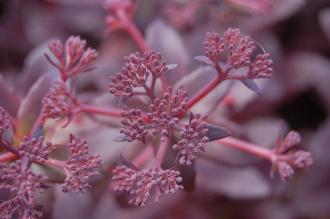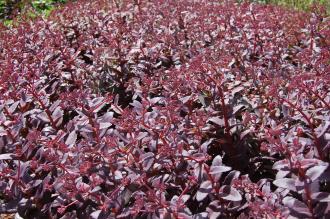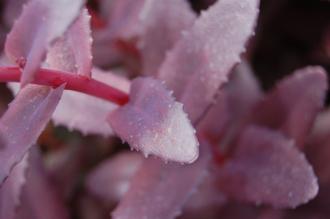
Sedum telephium ‘Purple Emperor’ Flower Buds (30/06/2012, Kew Gardens, London)
Position: Full sun
Flowering period: Late summer to early autumn
Soil: Moist, well drained
Eventual Height: 50cm
Eventual Spread: 50cm
Hardiness: 4a – 9b
Family: Crassulaceae
Sedum telephium ‘Purple Emperor’ is a fast growing, compact, deciduous, herbaceous perennial. Its dark purple/ red fleshy leaves are ovate to linear with serrate margins and are up to 6cm long. Its stems are red in coulour. Its pale pink flowers appear en mass in flat terminal cymes and are up to 10cm across.

Sedum telephium ‘Purple Emperor’ (30/06/2012, Kew Gardens, London)
The species, Sedum telephium, commonly known as Stonecrop, is native to most of Europe (including the UK). Sedum telephium is synonymous with Hylotelephium telephium.
The etymological root of the binomial name Sedum is derived from the Latin sedo ’settle’, a name used by Pliny describing how the cushion species of this genus hug the rocks. Telephium is from the Greek name thlefion, a name given to plants capable of indicating reciprocated love.
The landscape architect may find Sedum telephium ‘Purple Emperor’ useful in informal prairie type scheme, as part of a mixed herbaceous planting scheme or in wildlife gardens. Once established this plant is drought tolerant.
Ecologically, S. telephium ‘Purple Emperor’ is very attractive to pollinating insects.

Sedum telephium ‘Purple Emperor’ Leaf (30/06/2012, Kew Gardens, London)
The Royal Horticultural Society has given S. telephium ‘Purple Emperor’ their prestigious Award of Garden Merit in 2006.
S. telephium ‘Purple Emperor’ prefers moist, fertile, well-drained soils. It prefers a neutral to alkali pH of soil.
Sedum telephium ‘Purple Emperor’ requires little maintenance. Dead flower heads may be retained on the plant throughout the winter months to provide winter interest and cut off in early spring. Large clumps may be divided in spring.

